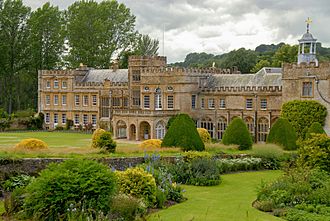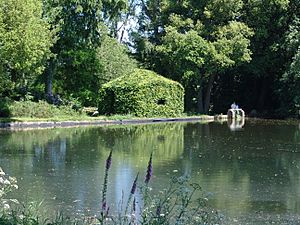Forde Abbey facts for kids
Quick facts for kids Forde Abbey |
|
|---|---|

Forde Abbey
|
|
| General information | |
| Town or city | Chard, Somerset |
| Country | England |
| Coordinates | 50°50′27″N 2°54′36″W / 50.84083°N 2.91000°W |
| Completed | 12th century |
|
Listed Building – Grade I
|
|
| Designated | 4 December 1951 |
| Reference no. | 1153362 |
Forde Abbey is a beautiful old building in Dorset, England. It used to be a Cistercian monastery, which is a place where monks lived and prayed. Today, it's a private home, but its amazing gardens and parts of the house are open for visitors to explore. It's also a working farm, covering about 1,600 acres (647 hectares). Forde Abbey is considered a very important historical building, listed as Grade I.
Contents
The Story of Forde Abbey
Forde Abbey started a long time ago, between 1133 and 1136. A rich nobleman named Richard de Brioniis built a small religious house called a priory. He invited 12 monks from another abbey to live there.
At first, the land wasn't very good for farming. So, in 1141, the monks thought about leaving. But Richard's sister, Adelicia, offered them a new place. This new spot was near the River Axe. It was called "Ford" because it was close to an old river crossing. The monks built their new priory here between 1141 and 1148. They dedicated it to the Virgin Mary.
Important People at the Abbey
Many important people were part of Forde Abbey's history.
- John of Ford was a leader at the abbey from 1191 to 1214. He was a friend of King John.
- The third abbot, Baldwin of Forde, became a very high-ranking church leader, the Archbishop of Canterbury.
- The abbey grew very rich and owned a lot of land, more than 30,000 acres (12,140 hectares) by the 1300s.
- A saint named Wulfric of Haselbury was buried at the abbey.
Changes After the Monks Left
In 1539, during a time called the dissolution of the monasteries, King Henry VIII closed many monasteries. Abbot Chard, the last abbot of Forde, gave the abbey to the King peacefully.
The abbey buildings were then rented out. Later, in 1649, a man named Edmund Prideaux bought Forde Abbey. He was a lawyer and supported the Parliament during the English Civil War. He made a lot of money and turned the abbey into his private home. He added new parts to make it more comfortable.
The house stayed mostly the same during the 1700s. The beautiful gardens we see today were started around this time. In 1815, a famous thinker named Jeremy Bentham rented the house. Over the years, different families owned Forde Abbey. Some took good care of it, while others didn't.
In 1905, the Roper family inherited the house. Their family still owns and lives in Forde Abbey today.
House and Gardens at Forde Abbey
When the monastery was closed, much of the original church was taken down. Only two statues from the old church have been found. They are now in the Great Hall.
Parts of the house that were once for the monks include:
- The Great Hall
- The north side of the old cloister (a covered walkway)
- The monks' living areas
- The Upper Refectory (dining hall)
- The Undercroft (a working area)
- The Chapter House (now a chapel)
Other rooms have been changed over time into grand State Rooms. Edmund Prideaux added new bedrooms and a reception area when he made it his home.
Exploring the Gardens
The gardens at Forde Abbey are a major attraction. They are considered very important historically. The Roper family has worked hard to keep them beautiful and improve them.
The gardens cover about 30 acres (12 hectares). They have many water features, colorful planted areas, and an arboretum (a collection of different trees). The large lawns in front of the house were created in the 1700s. Many of the trees were planted in the 1800s.
The Great Pond was originally used to power a watermill. Now, it feeds water down a series of waterfalls to three smaller ponds. These ponds were part of the 1700s garden design. Next to the Great Pond is the Beech House. This is a structure made from beech hedges. It was built in the 1930s for watching birds. There's also a Bog Garden nearby.
In the second largest pond, called the Mermaid Pond, the Roper family added the Centenary Fountain in 2005. This was to celebrate 100 years of their family owning Forde Abbey. It's claimed to be the highest powered fountain in England, shooting water up to 160 feet (49 meters) high!
Closer to the house, around the Long Pond, there are many flowering plants. They make the gardens very colorful in the summer. Behind the house, there's a Victorian walled kitchen garden. It used to grow food for the house. Today, it's mostly used to grow plants that visitors can buy.
Other Burials at Forde Abbey
- Renaud de Courtenay
- Edward de Courtenay, 3rd Earl of Devon
- Hugh Courtenay (KG)





